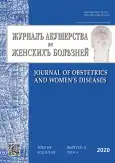Trends in safe infertility treatment with assisted reproductive technologies
- Authors: Paskar S.S.1, Kalugina A.S.1, Tkachuk A.G.1
-
Affiliations:
- Academician I.P. Pavlov First St. Petersburg State Medical University of the Ministry of Healthcare of the Russian Federation
- Issue: Vol 69, No 4 (2020)
- Pages: 83-88
- Section: Reviews
- URL: https://bakhtiniada.ru/jowd/article/view/33928
- DOI: https://doi.org/10.17816/JOWD69483-88
- ID: 33928
Cite item
Abstract
The expansion of indications for assisted reproductive technology has led to significant implications for assisted reproductive technology (ART) programs worldwide. More than 7 million children in the world were born using ART. Modern clinical practice in the field of reproductive sciences is aimed not only at increasing the effectiveness, but also at the safety of treatment. ART, like any other type of therapy, may be combined with negative side effects. Both the correct prediction of the risks associated with treatment and a personalized approach ensure the absolute safety of infertility treatment using in vitro fertilization. In this regard, over the past decade, a number of new research approaches have been noted that use ART methods integrated into clinical practice: cycle segmentation with subsequent embryo transfer and the elective transfer of one embryo. New approaches provide a control in relation to ovarian stimulation and a reduction in the number of transferred embryos, which helps to minimize primarily adverse perinatal outcomes. Predicting the risks and outcomes of treatment using mathematical modeling is the application of good clinical practice.
Full Text
##article.viewOnOriginalSite##About the authors
Svetlana S. Paskar
Academician I.P. Pavlov First St. Petersburg State Medical University of the Ministry of Healthcare of the Russian Federation
Author for correspondence.
Email: paskarsvetlana@mail.ru
ORCID iD: 0000-0002-9308-3241
SPIN-code: 2010-4379
Post-Graduate Student. The Department of Obstetrics, Gynecology, and Neonatology
Russian Federation, Saint PetersburgAlla S. Kalugina
Academician I.P. Pavlov First St. Petersburg State Medical University of the Ministry of Healthcare of the Russian Federation
Email: alla19021962@gmail.com
ORCID iD: 0000-0002-4796-7812
SPIN-code: 3214-1641
MD, PhD, DSci (Medicine), Professor. The Department of Obstetrics, Gynecology, and Neonatology
Russian Federation, Saint PetersburgAnna G. Tkachuk
Academician I.P. Pavlov First St. Petersburg State Medical University of the Ministry of Healthcare of the Russian Federation
Email: dr.anna.tkachuk@gmail.com
ORCID iD: 0000-0001-8344-7091
SPIN-code: 3783-3137
MD, PhD, Associate Professor. The Department of Obstetrics, Gynecology, and Reproductive Sciences
Russian Federation, Saint PetersburgReferences
- Adamson GD, Tabangin M, Macaluso M, de Mouzon J. The number of babies born globally after treatment with the assisted reproductive technologies (ART). Fertil Steril. 2013;100(3):42. https://doi.org/10.1016/j.fertnstert.2013.07.1807.
- Cheung AP. Assisted reproductive technology: both sides now. J Reprod Med. 2006;51(4):283-292.
- De Ziegler D, Gambone JC, Meldrum DR, Chapron C. Risk and safety management in infertility and assisted reproductive technology (ART): From the doctor’s office to the ART procedure. Fertil Steril. 2013;100(6):1509-1517. https://doi.org/10.1016/j.fertnstert.2013.10.020.
- Magnusson А, Källen K, Thurin-Kjellberg A, Bergh C. The number of oocytes retrieved during IVF: A balance between efficacy and safety. Hum Peprod. 2018;33(1):58-64. https://doi.org/10.1093/humrep/dex334.
- Luke B, Brown MB, Morbeck DE, et al. Factors associated with ovarian hyperstimulation syndrome (OHSS) and its effect on assisted reproductive technology (ART) treatment and outcome. Fertil Steril. 2010;94(4):1399-1404. https://doi.org/10.1016/j.fertnstert.2009.05.092.
- Tal R, Seifer DB, Khanimov M, et al. Characterization of women with elevated antimüllerian hormone levels (AMH): correlation of AMH with polycystic ovarian syndrome phenotypes and assisted reproductive technology outcomes. Am J Obstet Gynecol. 2014;211(1):59.e1-8. https://doi.org/10.1016/j.ajog.2014.02.026.
- Nargund G, Datta AK, Fauser BC. Mild stimulation for in vitro fertilization. Fertil Steril. 2017;108(4):558-567. https://doi.org/10.1016/j.fertnstert.2017.08.022.
- Oudshoorn SC, van Tilborg TC, Eijkemans MJ, et al. Individualized versus standard FSH dosing in women starting IVF/ICSI: an RCT. Part 2: The predicted hyper responder. Hum Reprod. 2017;32(12):2506-2514. https://doi.org/10.1093/humrep/dex319.
- Von Wolff M. The role of natural cycle IVF in assisted reproduction. Best Pract Res Clin Endocrinol Metab. 2019;33(1):35-45. https://doi.org/10.1016/j.beem.2018.10.005.
- Ashrafi M, Bahmanabadi A, Akhond MR, Arabipoor A. Predictive factors of early moderate/severe ovarian hyperstimulation syndrome in non-polycystic ovarian syndrome patients: A statistical model. Arch Gynecol Obstet. 2015;292(5):1145-1152. https://doi.org/10.1007/s00404-015-3723-0.
- Fauser BC. Patient-tailored ovarian stimulation for in vitro fertilization. Fertil Steril. 2017;108(4):585-591. https://doi.org/10.1016/j.fertnstert.2017.08.016.
- Olivennes F. Avoiding multiple pregnancies in ART. Double trouble: Yes a twin pregnancy is an adverse outcome. Hum Reprod. 2000;15(8):1663-1665. https://doi.org/10.1093/humrep/15.8.1663.
- Gelbaya TA. Short and long-term risks to women who conceive through in vitro fertilization. Hum Fertil (Camb). 2010;13(1):19-27. https://doi.org/10.3109/ 14647270903437923.
- Multiple gestation pregnancy. The ESHRE Capri Workshop Group. Hum Reprod. 2000;15(8):1856-1864. https://doi.org/10.1093/humrep/15.8.1856.
- Cutting R, Morroll D, Roberts SA, et al. Elective single embryo transfer: Guidelines for practice British fertility society and association of clinical embryologists. Hum Fertil (Camb). 2008;11(3):131-146. https://doi.org/ 10.1080/14647270802302629.
- Paulson RJ. Criteria for number of embryos to transfer: A committee opinion. Fertil Steril. 2013;99(1):44-46. https://doi.org/10.1016/j.fertnstert.2012.09.038.
- Centers for Disease Control and Prevention (CDC), American Society for Reproductive Medicine, Society for Assisted Reproductive Technology. 2013 Assisted Reproductive Technology: National Summary Report. Atlanta: US Department of Health and Human Services; 2015. Available from: https://www.cdc.gov/art/pdf/2013-report/art_2013_national_summary_report.pdf.
- Jacobs MB, Klonoff-Cohen H, Agarwal S, et al. Predictors of treatment failure in young patients undergoing in vitro fertilization. J Assist Reprod Genet. 2016;33(8):1001-1007. https://doi.org/10.1007/s10815-016-0725-1.
Supplementary files







